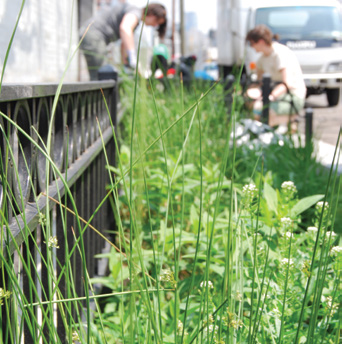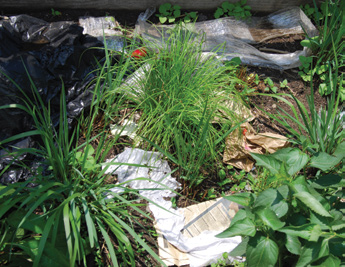Management.
Description + function
Containment and infiltration are the two most common approaches to managing onsite stormwater. Buildings with well-draining soil can often infiltrate rain water directly into the ground. Urban zero-lot-line sites or buildings with poorly draining soil can store rainwater on-site for slow release into a traditional storm sewer system.
Many municipalities now require some level of on-site rain water management in all new construction.
Strategy into action
Additional water storage capacity can be effective in small spaces, or in areas with non-porous soil.
Captured or stored rainwater should be treated as greywater. It is not potable, but can be used for irrigation or flushing toilets, depending on building codes.
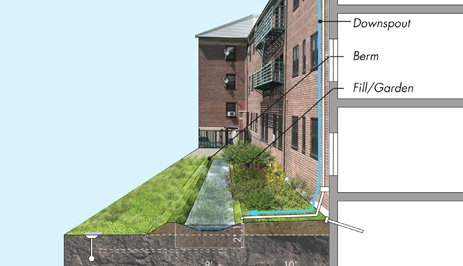
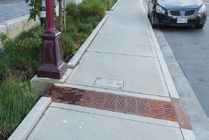
Water from rooftops and impermeable surfaces such as parking lots can be transferred to cisterns through direct piping or through vegetated filter areas, or bioswales. These systems are designed to store rainwater until the municipal storm sewer system is ready to handle additional volume after a large storm. They can be located next to streets or in a low area adjacent to a building.
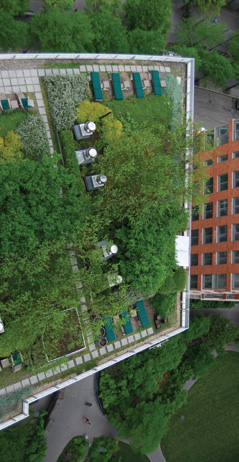
Vegetated or green roofs can support stormwater storage while providing increased roof insulation, reducing urban heat island effect, and creating new habitats and enhanced outdoor views. The roof may require reinforcement to handle the added weight, and large plants and trees can become a debris risk in high winds. Green roofs can be cost effective if a municipality requires a specified level of rain water storage and provides incentives for storage system installation.
Urban on-site water infiltration systems often include a permeable surface over crushed stone or gravel and an infiltration trench or drywell.
A water infiltration system starts with permeable pavers made of asphalt, concrete or a planted surface. Under the surface is usually 3 to 4 ft. of crushed stone, gravel or other loose fill material with rows of piping interlaid. This layer stores water before it infiltrates into the soil below. An effective stormwater management system should be designed to capture and hold the rainfall from a 5 to 10-year storm. Water collects in these underground storage systems and infiltrates slowly, often until well after the storm has ended.
Operations + maintenance
Permeable surfaces used for parking or driving require annual cleaning with a vacuum street sweeper. This fairly fast and easy procedure will help maintain permeability for many years. In pavers not designed to have vegetation, weed growth is a sign that too much sediment has been deposited and maintenance is required. Surface cleaning with a power washer is important in areas where salt is used for melting snow or ice. Avoid winter sanding of these paving systems as it will reduce permeability.
Drywells and cisterns should be inspected annually to flag any emerging problems.
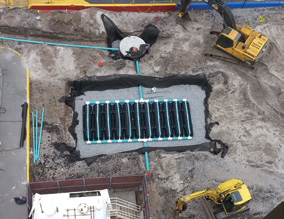
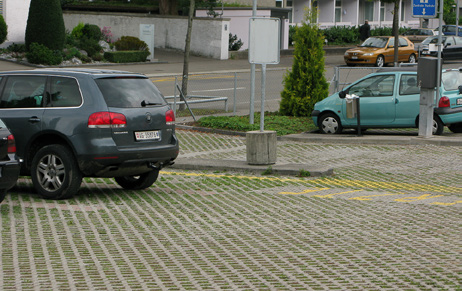
Estimated Cost
- $
- $$
- $$$
- $$$$
Supporting Strategies
Resources
- Cisterns: Design, Construction and Water Treatment, Penn State University. extension.psu.edu/natural-resources/water/drinking-water/cisterns-and-springs/rainwater-cisterns-design-construction-and-water-treatment
- Cistern Design, Stormwater Management Guidance Manual, Chapter 7, Philadelphia Water Department, City of Philadelphia, February 2014. www.pwdplanreview.org/upload/pdf/Full%20Manual%20(Manual%20Version%202.1).pdf
- EPA Stormwater Management resource page. water.epa.gov/polwaste/npdes/stormwater/
- Guidelines for the Design and Construction of Stormwater Management Systems, NYC Department of Environmental Protection and NYC Department of Buildings, July 2012. www.nyc.gov/html/dep/html/stormwater/stormwater_management_construction.shtml
- San Francisco Public Utilities Green Infrastructure Design Guidelines. www.sfwater.org/index.aspx?page=446
Background
A relic of unchecked industrial misuse, the Gowanus Canal is a Federal Superfund site. During Superstorm Sandy, many businesses and homes in the Gowanus area flooded with contaminated water and large amounts of raw sewage were released into the canal.
In 2011, the Gowanus Canal Conservancy (GCC) received funding from the NYC Department of Environmental Protection (DEP) and Environmental Protection Agency (EPA) to install and maintain 11 bioswales along a mixed residential and commercial corridor to reduce flooding and help clean the canal.
Strategy
The 11 bioswales manage 300,000 gallons of storm water each year. They intercept trash, which is then picked up by volunteers before it enters the canal. The bioswales also provide much-needed greenery for area residents. Maintenance includes keeping the bioswales clear of trash and weeds, watering the plants and cleaning sediment out of drains. Ongoing monitoring ensures that water quality is maintained. GCC volunteers maintain the bioswales and will pilot a stewardship course to engage local citizens.
Cost
The GCC received $874,470 for construction and three years of monitoring and maintenance of the bioswales.
